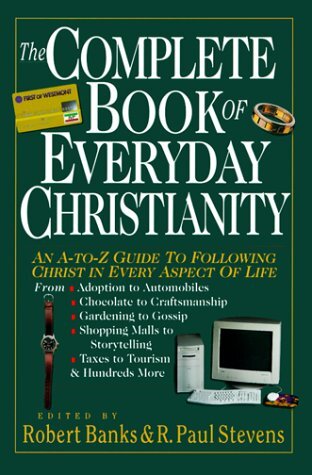Introduction
Book / Produced by partner of TOW
Everyday life is a complex affair. Most of it is made up of familiar situations, responsibilities, frustrations, pressures, conflicts, obligations, dilemmas and demands. In the midst of these we entertain hopes and expectations and meet satisfactions and disappointments. But sometimes crisis, public or private, intrude on the regular rhythms of our lives. New opportunities come our way; long-standing certainties are replaced by newly discovered ambiguities. The world around us changes, and it is hard to keep peace with all that is happening. If we are able to deal with portions of what is happening, the big picture often eludes us. Life easily becomes confusing, and the messages we pick up are often contradictory.
There are two further complications. First, those of us who are committed to connecting our faith with every part of our lives are not always sure bow to do so. If it is true, as the major Christian traditions have always insisted, that our religious convictions and values should be reflected in all that we do - the way we eat and drink, work and play, worship and vote, the quality of our parenting and friendships, our involvement with neighbors and of our parenting and friendships, our involvement with neighbors and colleagues, our engagement with popular or high culture - then there is much to consider. All these activities need to be related to our understanding of God, and whatever we learn must be incarnated in our behavior. How else will others know that God makes a distinctive claim on their lives? This is a daunting task, one we cannot handle alone but only with help from others.
Second, it would be easier for us to deal with these matters if there were a deposit of accumulated wisdom on which we could draw. Down through the centuries some impressive groups have developed an integrated approach to life. In such groups, everything was viewed through the lens of faith, hope and love. If the early monastic movements and medieval Christian orders did this for the few, the early Anabaptists and Puritans did it for the many. In the intervening years we have lost some of the breadth of such visions. We have compartmentalized life and either separated ourselves too much from the world or accommodated ourselves too much to it, generally without realizing what we are doing.
There is little to help us over this gap. Sermons are often too general, small groups avoid sensitive subjects, Christian magazines mainly deal with personal or relational issues, theological writings rarely address everyday concerns. This book seeks to provide what we are lacking. We have tried to make it as comprehensive, accessible and substantive as possible. While we have sought to make it practical, it is more than a self-help book because it analyzes wide issues, peers beneath the surface of the subjects it treats, and identifies some of the connections between them.
You can use The Complete Book of Everyday Christianity in a number of ways.
- You may have a particular interest you wish to pursue (such as developing a simpler lifestyle) or a felt need on which you require help (say, the issue of workaholism). All you have to do is look up such terms in the subject index, find the entries you want, and then follow any cross-references to related articles.
- You may be passing through a troublesome period of life (such as a midlife crisis) or facing a specific set of concerns (perhaps family problems). In such cases the Life Experience Index is especially helpful, since it lists a range of entries under various life stages and situations.
- You may be preparing a talk, study, sermon or workshop. As you do so, you may profitably consult entries directly in the dictionary itself. Alternatively, many entries in this volume would lend themselves to being part of a series of small-group or class discussion. You might develop a series with the help of the Life Experience Index, or create your own with the help of group cross-references in a major entry. For instance, a series on redeeming our daily routine might be based on articles about washing, chores, reading newspapers, commuting, office politics, coffee drinking, shopping and television.
- You may wish to use the volume as a textbook for a church or para-church-based class or a college or a seminary course. With regard to the first of these, you could consult the Life Activities, Interest & Concerns Index and take one of its main divisions and construct a series out of it, or choose a theme (such as community) that crosses several divisions. With regard to the second, we ourselves will be using the volume in courses on lifestyle ethics, marketplace ministry and the spirituality of everyday life.
- You may simply prefer, at times, to browse through the book when and where you have opportunity, moving from topic to topic as your interest takes you. Throughout the volume you will find numerous cross-references in see or see also listings.
For the two of us, working on this volume was an adventure that has developed a growing friendship and appreciation of one another. Through its hundred or so contributors, the book has also introduced us to a wide range of thoughtful practitioners who share some common interests. From the outset InterVarsity Press took a keen interest in the project and, with the help of Rodney Clapp, brought our "concept" into being. We are also grateful to the secretaries and research assistants who helped us at various points on this journey. Above all, we are thankful to God, for all the encouragement and sustenance that came to us along the way, and whose vision for all people and every part of creation is so astonishingly inclusive, vibrant and glorious.
(Originally published 1997. This text is taken from the 2011 version)
"Fire and Ice" from The Poetry of Robert Frost, edited by Edward Connery Lathem, Copyright 1951 by Robert Frost, Copyright 1923, © 1969 by Henry Holt and Company, Inc. Reprinted by permission of Henry Holt and Company, Inc.
Portions of "Baptism", "Sacraments", "Fellowship" and "Lord's Supper" originally published in New Testament Spirituality by Michael Green and Paul Stevens, Copyright © 1996. Used by permission of Eagle, United Kingdom. Distributed in North America by Harold Shaw Publishers, Wheaton, IL
Portions of "Body" originally published in Embodied Prayer: Harmonizing Body and Soul by Celeste Schroder, Copyright© 1995. Used by permission of Triumph Books, Liguori, MO.
Excerpts reprinted from Disciplines of the Hungry Heart by R. Paul Stevens, Copyright © 1993. Used by permission of Harold Shaw Publishers, Wheaton, IL 60189.
Excerpts reprinted from The Equipping Pastor by R. Paul Stevens and Phil Collins with permission from the Alban Institute, Inc., 4550 Montgomery Avenue, Suite 433N, Bethesda, MD 20814. Copyright© 1993. All rights reserved.
The article "Farming" is adapted from the "Long Range Vision Statement" of the organization EarthKeeping.
Portions of "Spiritual Gifts" originally published by Gordon Fee as "Gifts of the Spirit" in Dictionary of Paul and His Letters, edited by Gerald F. Hawtrone, Ralph P. Martin and Daniel G. Reid. Copyright © 1993 by lnterVarsity Christian Fellowship of the U.S.A. Used by permission of lnterVarsity Press, P.O. Box 1400, Downers Grove, IL 60515.





